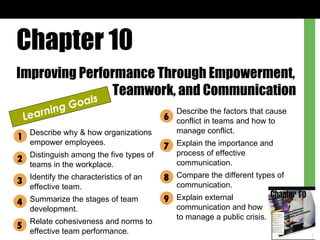
Cb12e basic ppt ch10
- 1. Chapter 10 Improving Performance Through Empowerment, Teamwork, and Communication Learning Goals Describe why & how organizations empower employees. Distinguish among the five types of teams in the workplace. Identify the characteristics of an effective team. Summarize the stages of team development. Relate cohesiveness and norms to effective team performance. Describe the factors that cause conflict in teams and how to manage conflict. Explain the importance and process of effective communication. Compare the different types of communication. Explain external communication and how to manage a public crisis. 1 2 3 4 5 6 7 8 9
- 2. EMPOWERING EMPLOYEES Empowerment Giving employees authority and responsibility to make decisions about their work without traditional managerial approval and control. Sharing Information and Decision-Making Authority • Ways to empower employees: • Keeping them informed about company’s financial performance. • Giving them broad authority to make workplace decisions that implement a firm ’s vision and its competitive strategy.
- 3. Linking Rewards to Company Performance Employee Stock Ownership Plans • 10 million workers at 11,500 companies participate. • Gives employees ownership, motivating them to work smarter and harder. Stock Options • Right to buy a specified amount of company stock at a given price within a given time period. • Being offered more and more to employees at all different levels.
- 4. TEAMS Team Group of employees who are committed to a common purpose, approach, and set of performance goals. • Hold selves mutually responsible and accountable for accomplishing objectives. • Ability to work on teams often emphasized during the hiring process. Work team A group of people with complementary skills who are committed to a common purpose. • Two-thirds of U.S. firms currently use them.
- 6. TEAM CHARACTERISTICS Team Size • Can range widely, but most have fewer than 12 members. • Research says ideal size is often six or seven members. Team Level and Team Diversity Team level Average level of ability, experience, personality, or any other factor on a team. Team diversity Variances or differences in ability, experience, personality, or any other factor on a team.
- 7. Stages of Team Development
- 8. Team Cohesiveness and Norms Team cohesiveness Extent to which team members feel attracted to the team and motivated to remain part of it. • Typically increases when members interact frequently, share common attitudes and goals, and enjoy being together. • Cohesive teams quickly achieve high levels of performance and consistently perform better. Team norm Informal standard of conduct shared by team members that guides their behavior. • Can be positive or negative.
- 9. Team Conflict Conflict Antagonistic interaction in which one party attempts to thwart the intentions or goals of another. • Cognitive conflict focuses on problem-related differences of opinion • Reconciling these differences strongly improves team performance. • Affective conflict refers to the emotional reactions that can occur when disagreements become personal rather than professional. • Strongly decreases team performance. • Team leader s should facilitate good communication so that teammates respect each other and work cooperatively.
- 10. THE IMPORTANCE OF EFFECTIVE COMMUNICATION Communication Meaningful exchange of information through messages. • Managers spend 80 percent of their time in direct communication with others. • Company recruiters rate effective communication as the most important skill they’re looking for in hiring new college graduates.
- 11. The Process of Communication
- 12. • All communication occurs in a situational or cultural context. • Communication in low-context cultures tends to rely on explicit written and verbal messages. • U.S., Switzerland, Germany, Austria • Communication in high-context cultures depends not only on the message itself but also on the conditions that surround it, including nonverbal cues, past and present experiences, and personal relationships between the parties. • Japan, Latin America, India
- 13. Basic Forms of Communication
- 14. Listening Receiving a message and interpreting its intended meaning by grasping the facts and feelings it convey. • Common listening behaviors: • Cynical listening Receiver of a message feels that the sender is trying to gain some advantage from the communication. • Offensive listening Receiver tries to catch the speaker in a mistake or contradiction. • Polite listening Receiver listens mechanically to be polite rather than to communicate. • Active listening Requires involvement with the information and empathy with the speaker ’s situation; the basis for effective communication. Grapevine Internal information channel that transmits information from unofficial source.
- 16. EXTERNAL COMMUNICATION: CRISIS MANAGEMENT External communication Meaningful exchange of information through messages transmitted between an organization and its major audiences. • Uses include: • Keep operations functioning • Maintain position in the marketplace • Build customer relationships by supplying information about topics such as product modifications and price changes. • Crisis management